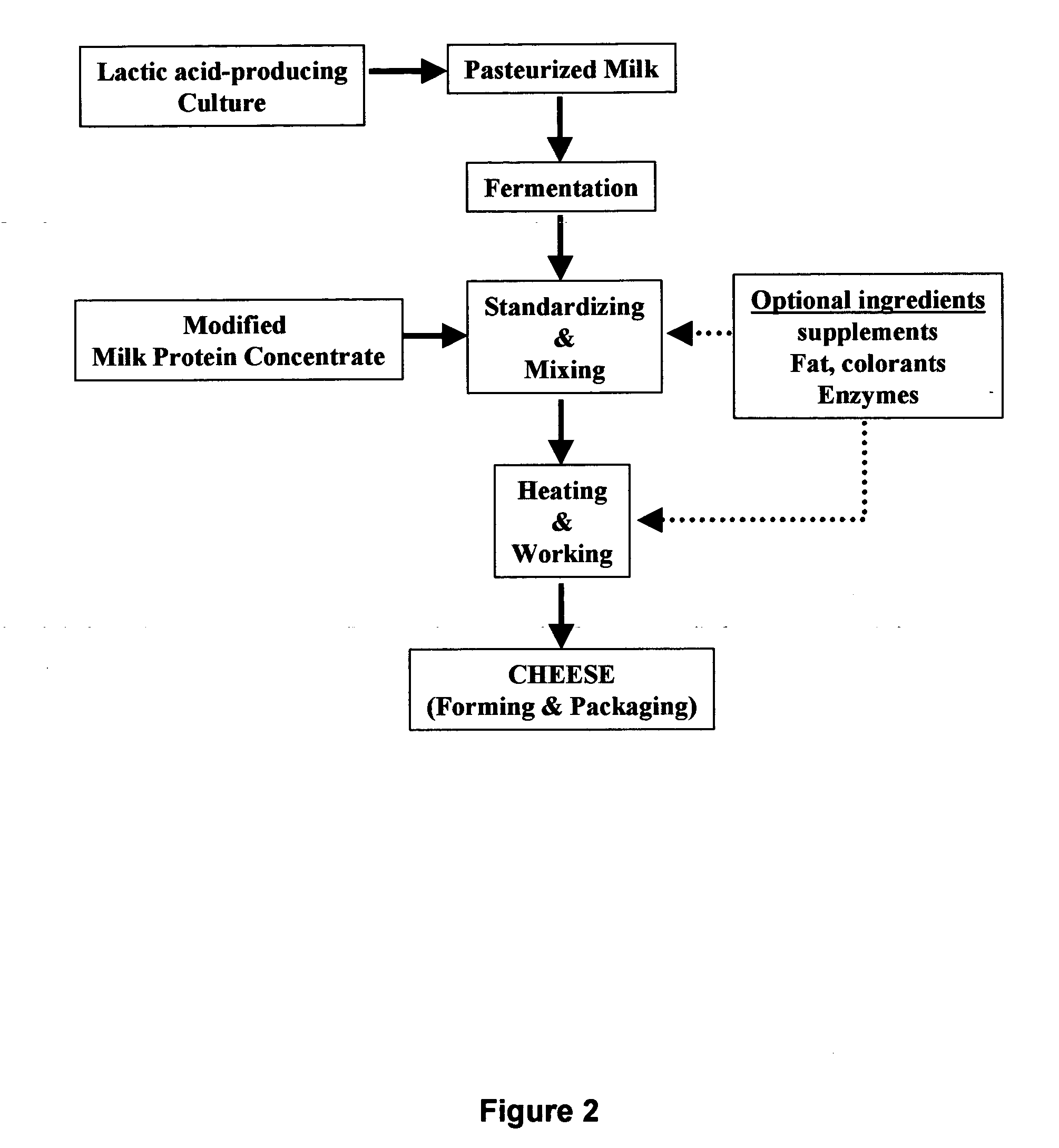No-whey process for production of low fat hard cheese
a low-fat, hard cheese technology, applied in the field of no-whey process, can solve the problems of reducing the production efficiency of hard cheese, so as to eliminate the cost of whey removal and reduce the processing requirements. , the effect of reducing the amount of fa
- Summary
- Abstract
- Description
- Claims
- Application Information
AI Technical Summary
Benefits of technology
Problems solved by technology
Method used
Image
Examples
example 1
A Low-Fat Mozzarella Style Cheese Having a 20 / 80 Ratio of Whey Protein to Casein is Prepared by the Following Method
[0046] 1) Mixing 1.91 pounds of 2% reduced fat milk, 1.00 pounds of modified milk protein concentrate (CPC-1, Interface Protein Technology, Inc. Naperville, Ill.), and 0.01 lb of lactic acid (88% acid) at room temperature in a blender (Artisan, Max Watts 325, St. Joseph, Mich.) for 5 minutes.
[0047] 2) Merging the blender into a hot water bath to heat the resulting slurry in the blender to about 168 degree F., and hold at the temperature for 30 seconds.
[0048] 3) Removing the melted cheese and packing into containers (0.5 lb each).
[0049] 4) Evaluating the cheese after 3 days of storage at refrigerator.
[0050] The resulting cheese has a fat content much lower than part skim mozzarella cheese as summarized in Table-1. While the resulting cheese has all whey proteins captured, results from a small testing panel indicate that the cheese had texture, flavor, and melting c...
example 2
A Cheddar-Style Cheese With all Whey Proteins Captured is Prepared by the Following Method
[0051] 1) Mixing 1.89 lb of whole milk (Safeway Inc., Pleasanton, Calif.), 0.55 lb melted anhydrate butter fat, and 1.08 pounds of modified milk protein concentrate (CPC-2, Interface Protein Technology, Inc. Naperville, Ill.) at room temperature in a blender (Artisan, Max Watts 325, St. Joseph, Mich.) for about 10 minutes and hold for about 30 minutes.
[0052] 2) Merging the blender into a hot water bath to heat the resulting slurry in the blender to about 158 degree F., and hold at the temperature for 10 seconds.
[0053] 3) Removing the melted cheese and packing into containers (0.5 lb each).
[0054] 4) Immediately cool down the packed cheese and stored in a refrigerator for 3 days before evaluating the resulting cheese.
[0055] While the resulting cheese has all whey proteins captured, results from a small testing panel indicate that the cheese had texture, flavor, and melting characteristics si...
example 3
A Parmesan-Style Cheese With all Whey Proteins Captured is Prepared by the Following Method
[0056] 1) Mixing 2.58 lb of whole milk (Safeway Inc., Pleasanton, Calif.) with about 0.8 g of LH32 and 1.2 g of Stc4 (Chr. Hansen, Milwaukee, Wis.).
[0057] 2) Incubating the cultured milk at about 110 degree F. for about 5 hours to drop pH to about 4.8.
[0058] 3) Mixing the above fermented milk with 0.69 lb of melted anhydrate butter fat, and 1.39 pounds of modified milk protein concentrate (CPC-3, Interface Protein Technology, Inc. Naperville, Ill.) at room temperature in a blender (Artisan, Max Watts 325, St. Joseph, Mich.) for about 10 minutes and hold for about 60 minutes.
[0059] 4) Merging the blender into a hot water bath to heat the resulting slurry in the blender to about 153 degree F., and hold at the temperature for 10 seconds.
[0060] 5) Removing the melted cheese and packing into containers (0.5 lb each).
[0061] 6) Immediately cool down the packed cheese and stored in a refrigerato...
PUM
 Login to View More
Login to View More Abstract
Description
Claims
Application Information
 Login to View More
Login to View More - R&D
- Intellectual Property
- Life Sciences
- Materials
- Tech Scout
- Unparalleled Data Quality
- Higher Quality Content
- 60% Fewer Hallucinations
Browse by: Latest US Patents, China's latest patents, Technical Efficacy Thesaurus, Application Domain, Technology Topic, Popular Technical Reports.
© 2025 PatSnap. All rights reserved.Legal|Privacy policy|Modern Slavery Act Transparency Statement|Sitemap|About US| Contact US: help@patsnap.com


